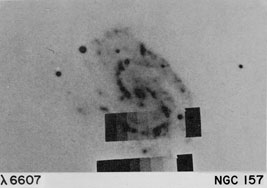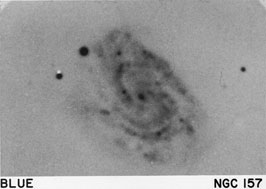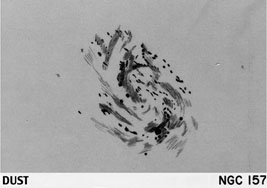


NGC 157. -
Burbidge, Burbidge,
and Prendergast (1961a)
report the presence of H all along the
slit (p.a. 30° and 50°) from 75"
northeast of the center to 82" southwest of the center. The authors
report that the rotation curve is similar to
NGC 7479. If the arms are
trailing, the SE side of the galaxy is the near one (i = 58°.6). Using
the values quoted by
Burbidge et al. (1961a)
(v = 1797, H
= 75 km s-1
Mpc-1, d = 24 Mpc) the primary dust lanes are about
400 pc in width and
can be traced along a spiral arc of about 1 kpc in length. There
appears to be a difference between location of the HII regions in the
NE (preceding) arm, where the bright emission regions are close to the
inside edge of the bright blue arm, and that of the HII regions in the
south following arm, where the emission regions appear to be near the
outer edge of the luminous blue arm.
all along the
slit (p.a. 30° and 50°) from 75"
northeast of the center to 82" southwest of the center. The authors
report that the rotation curve is similar to
NGC 7479. If the arms are
trailing, the SE side of the galaxy is the near one (i = 58°.6). Using
the values quoted by
Burbidge et al. (1961a)
(v = 1797, H
= 75 km s-1
Mpc-1, d = 24 Mpc) the primary dust lanes are about
400 pc in width and
can be traced along a spiral arc of about 1 kpc in length. There
appears to be a difference between location of the HII regions in the
NE (preceding) arm, where the bright emission regions are close to the
inside edge of the bright blue arm, and that of the HII regions in the
south following arm, where the emission regions appear to be near the
outer edge of the luminous blue arm.
The blue photograph reproduced in the Hubble atlas shows clearly the intricate structure of the dust in this galaxy; the enlargement should read 4X rather than 9.4X.
The nuclear region of NGC 157 is quite small and redder than the
arms, as can be seen from a comparison of the blue and
 6782
photograph. The H
6782
photograph. The H photograph
has the calibration photograph superposed by mistake.
photograph
has the calibration photograph superposed by mistake.

| 
|

| 
|